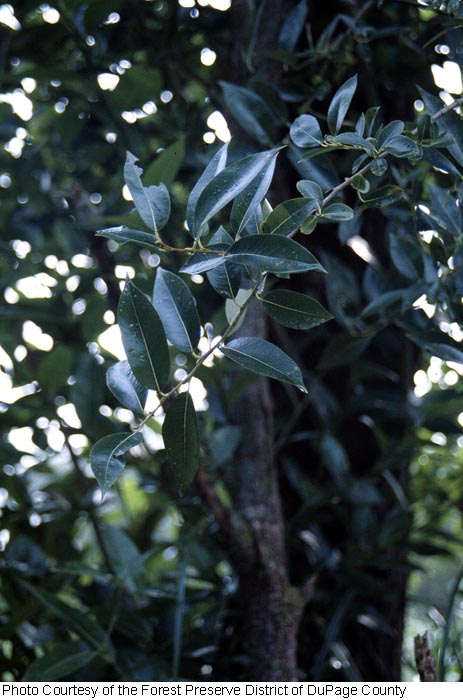|
|
|
|
Family: Salicaceae
meadow willow
[Salix gracilis Anderss., moreSalix gracilis var. rosmarinoides Andersson, Salix gracilis var. textoris Fernald, Salix neoforbesii Toepffer, Salix petiolaris var. angustifolia Andersson, Salix petiolaris var. gracilis (Andersson) Andersson, Salix petiolaris var. rosmarinoides (Andersson) C.K.Schneid., Salix petiolaris var. subsericea Andersson, Salix sericea var. subsericea (Andersson) Rydb., Salix subsericea (Andersson) C.K. Schneid.] |
Plants 1-6 m. Stems: branches red-brown or violet, not or weakly glaucous, (dull or slightly glossy), puberulent; branchlets yellow-green to red-brown, sparsely pubescent or moderately densely velvety, (buds alba-type or intermediate). Leaves: stipules rudimentary or absent; petiole shallowly grooved adaxially, 3-11 mm, pubescent, or velvety to glabrescent adaxially; largest medial blade lorate or very narrowly elliptic, 38-110 × 6-19 mm, 5-9 times as long as wide, base cuneate or convex, margins flat to slightly revolute, entire, serrate, serrulate, or spinulose-serrate, apex acute to acuminate, abaxial surface glaucous, densely long-silky to glabrescent, hairs (white, sometimes also ferruginous), adaxial dull or slightly glossy, glabrous or sparsely pubescent, (hairs white, sometimes also ferruginous); proximal blade margins sometimes serrulate; juvenile blade moderately densely long-silky abaxially, hairs white, sometimes also ferruginous. Catkins flowering as leaves emerge; staminate stout to globose, 12-29 × 6-17 mm, flowering branchlet 0.8-3 mm; pistillate loosely flowered, stout to globose, 12-39 × 6-18 mm, flowering branchlet 1-11 mm; floral bract brown, tawny, light rose, or bicolor, 1-2 mm, apex rounded, abaxially sparsely hairy, hairs straight. Staminate flowers: adaxial nectary square, ovate, or oblong, 0.3-0.7 mm; filaments distinct, hairy basally; anthers purple turning yellow, ellipsoid or globose, 0.4-0.6 mm. Pistillate flowers: adaxial nectary oblong to ovate, 0.3-0.9 mm; stipe 1.5-4 mm; ovary pyriform, beak abruptly tapering to styles; ovules 6-12 per ovary; styles 0-0.5 mm; stigmas slenderly to broadly cylindrical, 0.26-0.4-0.8 mm. Capsules 5-9 mm. 2n = 38. Flowering mid Apr-mid Jun. Sedge meadows, openings in moist, low, rich deciduous woods, sandy or peaty wet prairies, lakeshores; 10-2700 m; Alta., B.C., Man., N.B., N.W.T., N.S., Ont., P.E.I., Que., Sask.; Colo., Conn., Ill., Ind., Iowa, Maine, Mass., Mich., Minn., Nebr., N.H., N.J., N.Y., N.Dak., Ohio, Pa., S.Dak., Vt., Wis. See 107. Salix sericea for a comparative description. Because reproductive barriers between Salix petiolaris and S. eriocephala are weak, A. Mosseler (1990) suggested that their morphological variability may be due to interspecific gene flow. Hybrids: Salix petiolaris forms natural hybrids with S. bebbiana, S. candida, S. eriocephala, S. famelica, S. pellita, and S. sericea. Hybrids with S. alba have been reported (M. L. Fernald 1950) but no convincing specimens have been seen. Controlled pollinations with S. discolor produced no seed (A. Mosseler 1990). Reports of Salix petiolaris × S. sericea from Massachusetts and Pennsylvania (C. K. Schneider 1921) probably refer to the densely sericeous variant of S. petiolaris. It is sometimes named S. ×subsericea (Andersson) C. K. Schneider but does not seem to be a hybrid (G. W. Argus 1965, 1986; E. G. Voss 1972-1996, vol. 2).
Shrub or small tree to 7 m tall Leaves: alternate, on yellow, 4 - 10 mm long leafstalks, dark green above, with a waxy coating (glaucous) beneath, yellow on midrib, 5 - 10 cm long, 0.9 - 1.8 cm wide, narrowly lance-shaped to lance-shaped with a rounded base and pointed tip, finely toothed, firm, and glossy. Flowers: either male or female, borne on separate trees (dioecious) in hairy, cylindrical catkins. Female catkin greenish with yellow or brown scales. Ovary hairy. Male catkin 1 - 2 cm long with yellow or brown scales. Stamens two, with yellow anthers. Fruit: a capsule, in elongated clusters, stalked, slightly hairy, green to brown, 2 - 5 mm long, flask-shaped, and silky-hairy. Seeds have long, white, silky hairs attached. Bark: grayish green or reddish brown and smooth on young trees, becoming darker brown and scaly. Twigs: slender and purple to reddish brown. Buds: reddish brown, egg-shaped, and pointed. Similar species: In the Chicago Region, Salix petiolaris differs from most other willows by having finely toothed, hairless leaves that exhibit a waxy coating on the lower surface. Also, the leaf margins are not revolute (rolled downward). Salix amygdaloides, which is similar, has broader leaves and is larger, while S. fragilis has longer, wider leaves and is also larger. Flowering: late April to late May, with the leaves Habitat and ecology: Locally frequent in the wet calcareous meadows and fens of the Chicago Region's western sector. Occasional in the southern and eastern sectors in sandy peaty areas. Also found on floating sedge mats, along rivers, and in other moist areas. Occurence in the Chicago region: native Notes: For a taxonomic discussion of Salix petiolaris consult Argus (1964). Etymology: Salix is the Latin word for willow. Petiolaris means "with leaf stalks." Author: The Morton Arboretum Clumpy shrub to few-stemmed tree (northward), (1-)2-7 m; twigs slender, yellowish and puberulent to dark brown and glabrous; stipules minute or none; petioles slender, 5-15 mm; lvs narrowly lanceolate or narrowly oblanceolate, 4-10(-15) נ0.8-2(-3) cm, acute to acuminate, subentire to closely glandular-serrulate, densely sericeous on both sides when unfolding from the bud, later dark green and glabrous above, glabrous and glaucous beneath (rarely more persistently hairy); catkins with the lvs, 1-3.5 cm, lax, subsessile or on bracteate peduncles 1-2 cm; scales 1.5-2 mm, brown, thinly villous; stamens 2; frs lanceolate-rostrate, 4-8 mm, thinly sericeous; pedicels 2.5-5 mm; style 0.1-0.5 mm; 2n=38. Moist meadows, stream-banks, and lake-shores; N.B. to N.J. and Pa., w. to Alta., n. Nebr., and Colo. Low shrubs with small lvs 3-6 cm and subentire have been called var. angustifolia Andersson (S. gracilis), but the 3 characters are not well correlated. Gleason, Henry A. & Cronquist, Arthur J. 1991. Manual of vascular plants of northeastern United States and adjacent Canada. lxxv + 910 pp. ©The New York Botanical Garden. All rights reserved. Used by permission. |
|
|
|


